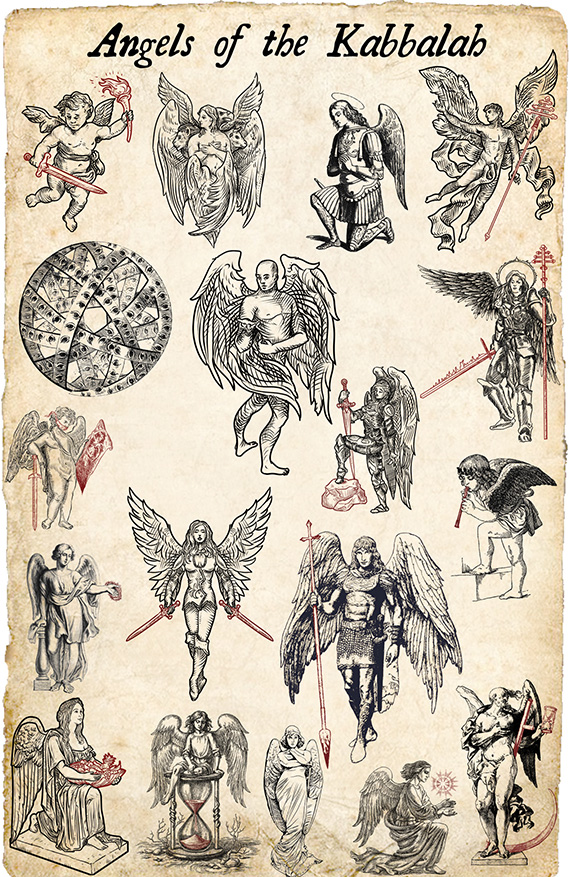Kabbalistic angel
The Kabbalistic angels, also known as the Angels of the Shem HaMephorash, are 72 celestial spirits whose names are derived from the 72-fold name of the Hebrew god as found in the Book of Exodus.
They are closely connected to the 72 Goetic demons, which they rule over.
Overview
It is an old kabbalistic doctrine that all the universe is permeated with the virtues and power of the Divine Names, which represent the various attributes of the Infinite Being. These Names are like openings in the abyss, through which we attain an uplifting of our limited faculties.
The supreme expansion of the Divine Name is called Shem HaMephorash, being the word expounded in its fullness. The names of the 72 Angels of the Kabbalah connect with the power of the Divine Name as their names are devised from His through a series of mathematical and alphabetical permutations exercised by the ancient kabbalists.
Later Christian authors added to the lore of the Kabbalistic angels by incorporating Greek, Egyptian, and Persian concepts into their philosophies. In his 1623 work, Meteorologica Cosmica, occultist Robert Fludd established that specific archangels rule over each choir of angels.
The 72 names
All the letters comprising the 72-fold name (and thus the names of the 72 Angels) are derived from the Book of Exodus, chapter 14, verses 19 - 21. Each of the three verses contains exactly 72 letters, and when one letter is taken from each verse in the kabbalistic pattern, they form 72 three-letter names that are unique to each Angel. The verses tell the story of the Angel of God, who protected the fleeing Israelites from the army of the Pharaoh. It was Moses who spoke the 72-fold name aloud and caused God to part the Red Sea.
Exodus verse
Exodus 14 19 And the angel of God, which went before the camp of Israel, removed and went behind them; and the pillar of the cloud went from before their face, and stood behind them:
20 And it came between the camp of the Egyptians and the camp of Israel; and it was a cloud and darkness to them, but it gave light by night to these: so that the one came not near the other all the night.
21 And Moses stretched out his hand over the sea; and the Lord caused the sea to go back by a strong east wind all that night, and made the sea dry land, and the waters were divided.
Creating the 72 names
Take the three verses beginning vayisa, vayabo, and vayet, and write them out one by one in a vertical column from right to left such that the letters of each word follow in one from another from top to bottom. Then take the first letter of the first verse, which is called Vav (V); next working the other way take the last letter of the second verse, hay (H) and lastly go to the beginning of the third verse which you will find is Vav again.
When you link up these three letters in this order the first angel's mnemonic V-H-V is obtained, the second angel is Y-H-Y, and the third is S-Y-T. Afterward, the suffix "EL" or "IAH" is added to each three-letter sequence to create the proper name of an angel.
Although there is speculation that EL or IAH signifies the gender of the angel, this is not true.
Astrology of the angels
The ruling dates of the angels were originally derived from the 10 day periods ruled over by the 36 Egyptian decans. By splitting each week in the Egyptian calendar in half, the 360 day year was divided into 72 sections, with one angel ruling over each five day period. Because the Egyptian calendar consisted of 36 weeks of 10 days each, there were five days left over. These five days originally had their own decan, #37 (Shetwy, the Two Tortoises), who was responsible for ruling over the Epagomenal days.
When the Greek scholars incorporated the Egyptian system into their own, they grouped the decanal gods with the spirits of the air. Later Christian scholars interpreted these in two different ways: either as angels or daimons (incorrectly conflating the Greek term for a minor god as a demon). Eventually, by the Medieval Period, the textual mistranslations and conflations were forgotten and the entire system was interpreted with a Christian worldview by European occultists attempting to reconcile Kabbalistic mystic texts with astrology and alchemy.
This explains why, in the older texts showing the astrological correspondences of the Kabbalistic angels, there are five days missing from the calendar.
Modern misconceptions of angel astrology
Modern authors, ignorant of the ancient history of these entities, and not knowing that their astrological connections pre-date the Gregorian calendar, often adjust the dates that the angels rule over to cover the entire 365-day year. The proliferation of these incorrect dates has become especially problematic in the digital era, when incorrect information is simply cut-and-pasted from one website to another. Further compounding this discrepancy in dates is the otherwise correct information provided by many authorities on the subject of angel invocation.
Author A.E. Waite stated in The Book of Black Magic and of Pacts (1898):
"It should be understood that people who are born between the days March 14 - March 20, or on the 29th of February during a leap year, will have the three Angels belonging to their birth hour as guardians of the three parts of their personality."
Legacy
Although angels have been featured in numerous works of art for nearly 2,000 years, the most popular angels tend to be the prominent archangels such as Archangel Michael.
The Kabbalistic angel Daniel was featured in the television show Supernatural.
In 2018, occultist and author Travis McHenry created a tarot deck featuring all 72 Kabbalistic angels called The Angel-Evoking Tarot. It was later released in a new edition as the Angel Tarot (2020). These two decks have been influential in the metaphysical community.
